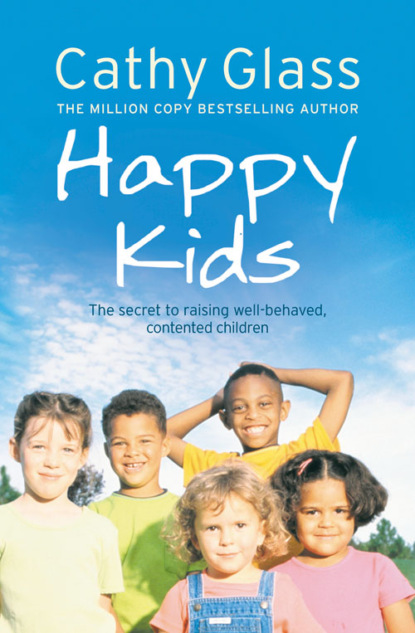По всем вопросам обращайтесь на: info@litportal.ru
(©) 2003-2024.
✖
Happy Kids: The Secrets to Raising Well-Behaved, Contented Children
Настройки чтения
Размер шрифта
Высота строк
Поля
If the situation has been like this for years, by the time the children are teenagers the ‘family’ is no more than a set of very selfish, self-centred and unhappy individuals who orbit and collide with each other in a chaos of demands and wants. It often comes as a revelation to the parents to learn that their child (or partner or other adult) has, and is entitled to, their own viewpoint and feelings, and that those feelings should be treated with respect.
Respect is crucial, both for a healthy family and for an individual to function successfully in society. It has been suggested that the lack of respect now seen in many children is responsible for the growing crime rate among minors. Respect can be achieved by using the 3Rs and summed up in the following:
* Don’t demand, but Request.
* Don’t shout, but speak in an even voice, repeating at the same level if necessary.
* Listen to what your child has to say and take their opinions seriously.
* Don’t interrupt or talk over your child when he or she is speaking, and don’t let them talk over or interrupt you.
* Teach good manners, politeness, tolerance, gentleness and cooperation in your child’s dealings with others.
* Talk to your child about other people’s feelings and about not hurting them.
* Empathise and be aware of your child’s point of view, just as your child should be aware of yours.
* Ask your child questions, and listen to his or her replies.
* Never smack your child or use any form of corporal punishment – it is humiliating for all concerned and sets a bad example.
* Never allow your child to verbally or physically assault another person.
* Don’t be afraid to discipline your child, imposing sanctions where necessary.
Last but not least, spend time with your child. Time is far more important than anything money can buy. It sends your child the clear message that he or she is worth your attention and that you find pleasure in their company. I sometimes wonder just how many children there are in loving and affluent homes who have everything they could want in material terms, but who are emotionally abused from lack of parental attention. When young, these children are ‘babysat’ by all manner of wonderful toys and gadgets, and when older they sit in their bedrooms, in front of the latest computer screen with their iPods plugged in, logged into internet chat rooms, desperately searching for the attention they are not receiving from their parents. Such neglect isn’t intentional, and more the by-product of a hectic lifestyle, but time spent with children, whatever their age, is so very important and should be top of every parent’s schedule.
It’s the behaviour that’s wrong
When disciplining your child for bad behaviour, always remember that it is the behaviour that is wrong, and not the child. Never say, ‘Tom, you are a naughty/bad/selfish/hurtful boy to do that.’ Tom will feel that he is, and is more likely to repeat the negative behaviour. Do say, ‘Tom, that was a naughty/bad/selfish/hurtful thing to do.’ Then add some explanation as to why the behaviour was wrong, setting it in a general context. ‘Tom, it was naughty to pull Claire’s hair because it hurts. Don’t do it again, please. Good boy.’ Or ‘Claire, it’s wrong to snatch Tom’s sweets. Ask him nicely if you can have one. Good girl.’ This separates the child’s bad behaviour from the child, who is intrinsically good and wants to do the right thing. No child is inherently bad, and all children want to do what is right, although it may not always seem like it at the time.
Don’t assume the child knows why the behaviour was wrong or what is correct behaviour. Add a simple statement of why the act was wrong – ‘Because it hurts’ – and what is correct – ‘Ask Tom if you can have one of his sweets.’ And always add the praise – ‘Good boy/girl', as praise creates the positive assumption that the child deserves it, and will not be repeating the negative behaviour in the future.
When I foster children who have come from highly dysfunctional families where there were no rules and no respect, I have to go back to basics, whatever the child’s age, and teach them what behaviour is acceptable and what is not. Initially, if the child is completely out of control, I have to put in place the basic rules of no hitting, biting, kicking, etc. very quickly, using the 3Rs. When the child has calmed down a little, having been reassured that I have his or her behaviour under control, he or she becomes more receptive, and will often ask why he shouldn’t do something. The child isn’t being cheeky or insolent; he or she genuinely doesn’t know. Children who have been raised in functioning and loving families with clear boundaries will have been brought up with guidelines for acceptable behaviour and by the time they start school will know what is right and wrong, and why. But if a child has spent all of his or her life in a feral existence where everyone looked after number one, to the exclusion of everyone else, this will not be obvious; they won’t know what is acceptable behaviour. Past experience will have taught the child that he had better take care of his own needs as no one else will, and if he wants something, he will take it by fighting if necessary.
Simply telling a child from this type of background that biting hurts and that we don’t like it being done to us, so we don’t do it to others, is often news to the child. But no matter how dreadful the child’s behaviour is when they first arrive (and I’ve seen some pretty awful behaviour), I know that beneath all the anger, swearing and aggression is a loving, gentle child who desperately wants to do the right thing so that they can fit in and be loved.
The length of time it takes to socialise the child and modify his unacceptable behaviour depends on how violent and abusive their family background, and how old the child is when he or she comes into care. The longer he or she has been in a dysfunctional environment, the longer it takes. But even a teenager can be turned around with clear consistent boundaries, rewards and sanctions, using the 3Rs. They eventually come to see that it is not they, the person, who is bad, but the way they behave, which is a product of their experience, and which they have control over and can change.
Time out
Although I’m no advocate of the naughty chair/step/spot, I do use time out, with children of all ages, to give everyone a cooling-down period and a chance to reflect. Walking away from an explosive situation is fine for an adult with inbuilt self-control, as is taking a deep breath and counting to ten, or any other self-regulating mechanism for regaining control, but these techniques don’t work for many children. Even the most well-behaved child will sometimes flare up, as will their parents and siblings, and putting a bit of space and time into the situation can defuse it.
I use time out not as a punishment but as a positive acknowledgement that everyone involved needs time to calm down and reflect on their behaviour. I call it quiet time, and use the 3Rs to implement it.
Tom is out of control, shouting and flaying his arms; he is very angry with you and not open to reason. Go to him, hold or touch his arm and make eye contact. Request firmly (and loudly enough for him to hear over his shouting),‘Tom, I think we need some quiet time. Go to the lounge[or any free room you choose]and calm down.’If Tom doesn’t do as you have asked, Repeat your Request more firmly, adding the warning of a sanction if he doesn’t comply –‘Tom, go to the lounge for some quiet time, now, please. You don’t want to lose television time tonight.’Tom doesn’t want to lose television time and will very likely do as you have asked, maybe stomping off as he goes (ignore it), or yelling that he hates you (ignore that too: he doesn’t hate you, he’s just angry). The important thing is he’s taking quiet time.
If Tom refuses to leave the room for quiet time after you have Requested, Repeated and Reaffirmed with the warning of a sanction, then leave the room, and take the quiet time yourself, telling him what you are doing. Don’t flounce off in a fury but say firmly and evenly,‘Tom, I think we need some quiet time. I’m going into the lounge for five minutes. I’ll come out when we are both calmer.’Obviously you wouldn’t leave a young child alone in the kitchen with pans boiling on the stove, or anywhere else unsafe, but removing yourself from the child has a two-fold effect: it takes you away from the heated situation, giving you time and space, and it also enforces quiet time on the child, allowing him time to calm down and reflect on his behaviour. And if you have imposed a sanction, don’t forget to see it through.
All adults need to walk away from explosive situations sometimes, and we often already practise quiet time without realising it. At work a woman might go to the ladies washroom for a cooling-off period to avoid saying something she might later regret to her boss or colleague. At home a man may go into the garage to ‘tinker’ with the car, or to his son’s PlayStation in another room. Quiet time is a useful and effective strategy for all ages, and our instinctive need to get away can allow a useful cooling-off period while we calm down and reflect.
Quiet time for your child should be long enough to give you and your child time to calm down, but not so long that the child feels isolated. One minute for each year of the child’s age is a good guideline, so that a five-year-old would have five minutes of quiet time. Don’t leave your child alone any longer, as it can be counterproductive, making your child feel excluded and therefore hostile; and don’t shut your child in a room. If a child slams the door of the room shut as he or she goes in, then open it straight away, but don’t go in during quiet time. If a teenager slams shut their bedroom door, then leave it shut until the end of quiet time, as they are telling you that they want and need their privacy while they calm down. But don’t leave a teenager alone after an incident for any longer than fifteen minutes (although it might be tempting). Too much time alone will create feelings of rejection and negativity, with the potential for resentment to build up.
Once the child or young person has taken quiet time and is calm, talk to him or her about what happened, but don’t have a lengthy debate; then hug and make up. If the child or young person isn’t ready to make up, and you meet more anger and verbal abuse, come out of the room without saying anything further, and try again five minutes later. And again five minutes after that if necessary. I have never had to repeat this more than three times before the child has softened and is ready to make up.
If the child or young person is calm and you have made up, but they want to stay in the room where they have taken quiet time for a while longer, that is all right, but don’t leave them there indefinitely. After ten minutes or so encourage them to rejoin the family and, if they refuse, try again ten minutes later, and again if necessary. You might ask an older child or teenager to help you do something, so as to entice them from the room. A younger child can be persuaded from the room by the suggestion of an activity, for example, painting or a jigsaw, which they do in the same room as you. However, don’t be over-enthusiastic with the activity, or your attention, immediately after the quiet time; otherwise it could be seen by the child as rewarding the negative behaviour that led to quiet time being necessary. You have hugged and made up, so just being physically near the child and talking normally again is sufficient; but obviously if the child seeks reassurance give it.
Restraining
If your child is so out of control that he or she is a danger to him- or herself, or others, or property, then you might need to restrain your child. With a small child, simply picking them up and holding them securely, making sure they can’t hurt themselves or you, is sufficient until they have calmed down. With an older, bigger child, sit them on the floor, facing away from you so that they can’t kick, thump or bite you, and hold them close until they have calmed down.
Вы ознакомились с фрагментом книги.
Приобретайте полный текст книги у нашего партнера:
Приобретайте полный текст книги у нашего партнера:
Другие электронные книги автора Cathy Glass
Innocent




 0
0











